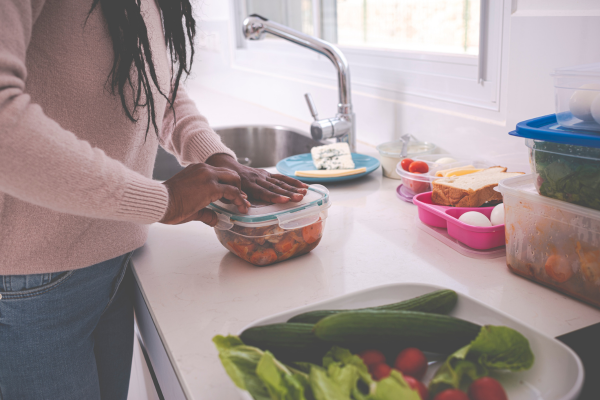
Practicing food safety keeps us healthy and lets us enjoy the foods we eat. Food safety guidelines include washing hands, cleaning surfaces that come in contact with raw foods, cooking foods to high enough temperatures, and storing foods properly. Temperature is very important during cooking, and also for food storage. Harmful bacteria that cause illness grow most quickly between 41 °F and 135 °F, such as when foods are cooled too slowly and not reheated enough.1 Thinking about this, let’s talk about reheating leftovers and refreezing food.
How many times can I reheat leftovers?
It’s best practice to reheat leftovers only once. Separate the portion you want to reheat, and leave the rest of the leftovers in the fridge. When you repeatedly heat and cool leftovers, the risk for food poisoning increases. Be sure to reheat leftovers completely to 165 °F. If you are using a microwave, remove leftovers halfway through the reheat and stir to distribute the heat and eliminate cold spots. In the instance you do need to put reheated leftovers back in the fridge, do so within 2 hours of reheating (sooner is better).2
Can I refreeze food I thawed?
You may refreeze a frozen food after it’s thawed, but only if it’s thawed in the refrigerator. This ensures it was kept below 41 °F and the range where harmful bacteria could grow rapidly. Foods lose moisture while thawing, so the re-freezing and re-thawing will likely cause the quality of the food to decrease. If you use any other thawing method, the food needs to be fully cooked before freezing again. If you leave any food outside of the fridge for more than 2 hours, do not refreeze it.3
Keep these general food safety guidelines4 in mind:
- Clean your hands, food prep surfaces, and cooking space.
- Separate raw meat, poultry, and fish from all other foods.
- Cook foods to appropriate temperatures.
- Chill foods properly and soon after cooking.
For more on food safety, look at our blog posts on Leftover Food Safety, Risky or Not?, and Baking Food Safety.
- Basic Food Safety. Safe Plates, NC State Extension. Updated September 8, 2021. Accessed March 29, 2023. https://foodsafety.ces.ncsu.edu/wp-content/uploads/2021/11/BasicFood-Safety-SP@Home.pdf?fwd=no
- How many times can I reheat food? AskUSDA, US Department of Agriculture. Updated March 23, 2023. Accessed March 29, 2023. https://ask.usda.gov/s/article/How-many-times-can-I-reheat-foods
- Freezing and Food Safety. Food Safety and Inspection Service, US Department of Agriculture. Updated June 15, 2013. Accessed March 29, 2023. https://www.fsis.usda.gov/food-safety/safe-food-handling-and-preparation/food-safety-basics/freezing-and-food-safety
- Keep Food Safe! Food Safety Basics. Food Safety and Inspection Service, US Department of Agriculture. Updated December 20, 2016. Accessed March 29, 2023. https://www.fsis.usda.gov/food-safety/safe-food-handling-and-preparation/food-safety-basics/steps-keep-food-safe
You might also enjoy:
Don’t miss another great blog: Subscribe Now
